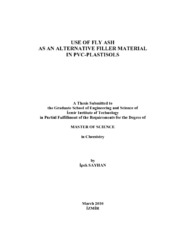Please use this identifier to cite or link to this item:
https://hdl.handle.net/11147/3041Full metadata record
| DC Field | Value | Language |
|---|---|---|
| dc.contributor.advisor | Polat, Hürriyet | en |
| dc.contributor.author | Sayhan, İpek | - |
| dc.date.accessioned | 2014-07-22T13:50:46Z | - |
| dc.date.available | 2014-07-22T13:50:46Z | - |
| dc.date.issued | 2010 | en |
| dc.identifier.uri | http://hdl.handle.net/11147/3041 | - |
| dc.description | Thesis (Master)--İzmir Institute of Technology, Chemistry, İzmir, 2010 | en |
| dc.description | Includes bibliographical references (leaves: 74-78) | en |
| dc.description | Text in English; Abstract: Turkish and English | en |
| dc.description | xii, 78 leaves | en |
| dc.description.abstract | In this study, an alternative filling material, fly ash was tested in PVC pastisols. Therefore, - 38 .m Soma fly ash sample was used and its results were compared with that of calcite material as a filler. Therefore, this study was conducted to have three sections as: 1) Characterization of powders calcite, fly ash and PVC powder: SEM, XRF, XRD, Size measurement, 2) Preparation and characterization of PVC plastisols with and without fly ash: Rheological measurements 3) Characterization of final PVC product: Surface, hardness and strength tests. The results of fly ash were always compared with the results of calcite and discussed in this thesis. It was suggested that fly ash could be an alternative filling material for PVC plastisols. It.s effect, on the other hand, was found to change depending on the temperature, mixing speed and concentration. In overall, the mechanical properties of PVC-product obtained were affected positively and better PVC materials were obtained. Under some conditions, however, the rheological properties were became shear thickening while it was newtonian and shear thining before. The changes in the rheological properties of PVC plastisols and the mechanical properties (quality) of final PVC-product were all explained by the differences in the composition and shape of the fly ash particles. Because, the composition and shape of the particles are expected to affect the interactions of PVC particles with that of filler material which will definetely affect the quality of material. | en |
| dc.language.iso | en | en_US |
| dc.publisher | Izmir Institute of Technology | en_US |
| dc.rights | info:eu-repo/semantics/openAccess | en_US |
| dc.subject.lcsh | Fillers (Materials) | en |
| dc.subject.lcsh | Polyvinyl chloride | en |
| dc.subject.lcsh | Plastisols | en |
| dc.subject.lcsh | Fly ash | en |
| dc.title | Use of fly ash as an alternative filler material in PVC-pastisols | en_US |
| dc.type | Master Thesis | en_US |
| dc.institutionauthor | Sayhan, İpek | - |
| dc.department | Thesis (Master)--İzmir Institute of Technology, Chemistry | en_US |
| dc.relation.publicationcategory | Tez | en_US |
| item.languageiso639-1 | en | - |
| item.fulltext | With Fulltext | - |
| item.openairecristype | http://purl.org/coar/resource_type/c_18cf | - |
| item.openairetype | Master Thesis | - |
| item.grantfulltext | open | - |
| item.cerifentitytype | Publications | - |
| Appears in Collections: | Master Degree / Yüksek Lisans Tezleri | |
Files in This Item:
| File | Description | Size | Format | |
|---|---|---|---|---|
| T000830.pdf | MasterThesis | 2.81 MB | Adobe PDF |  View/Open |
CORE Recommender
Page view(s)
868
checked on Jul 22, 2024
Download(s)
128
checked on Jul 22, 2024
Google ScholarTM
Check
Items in GCRIS Repository are protected by copyright, with all rights reserved, unless otherwise indicated.